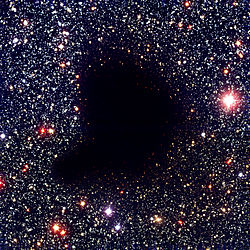Barnard 68
| Dunkelnebel[1], Molekülwolke[1] | |
|---|---|
| Barnard 68 | |
 | |
| Aufnahme des Very Large Telescope | |
| Sternbild | Schlangenträger |
| Position Äquinoktium: J2000.0 | |
| Rektaszension | 17h 22m 38,2s [1] |
| Deklination | −23° 49′ 34″ [1] |
| Weitere Daten | |
| Entfernung | 500 Lj [2] |
| Zugehörigkeit | |
| Durchmesser | 0,5 Lj [2] |
| Geschichte | |
| Katalogbezeichnungen | |
| Barnard 68 • LDN 57 | |
| AladinLite | |
Barnard 68 ist eine Dunkelwolke beziehungsweise Bok-Globule. Sie liegt in dem südlichen Sternbild Schlangenträger und ist etwa 500 Lichtjahre entfernt. Das Innere der Wolke ist sehr kalt, die Temperatur liegt bei rund 9 Kelvin (−264 °C).[3][4] Die Gesamtmasse entspricht etwa der doppelten Sonnenmasse, wobei die Wolke eine Ausdehnung von einem halben Lichtjahr hat.[2]
Die Katalogbezeichnung der Dunkelwolke geht darauf zurück, dass der Astronom Edward Emerson Barnard sie 1919 in seinen 1927 publizierten, 350 Objekte umfassenden Katalog von Dunkelnebeln aufnahm.
Weblinks
- The Black Cloud – Ken Croswell (englisch)
- C18O abundance in the nearby globule Barnard 68 (englisch)
- ESO: How to Become a Star – ESO Telescopes Provide Most Detailed View Ever Into a Dark Cloud (englisch, 10. Januar 2001)
Einzelnachweise
- ↑ a b c SIMBAD Astronomical Database (Barnard 68). Centre de Données astronomiques de Strasbourg. Abgerufen am 1. März 2009.
- ↑ a b c Molecular Cloud Barnard 68 – Astronomy Picture of the Day vom 11. Mai 1999 (englisch).
- ↑ M. Nielbock, R. Launhardt, J. Steinacker, A. M. Stutz, Z. Balog: The Earliest Phases of Star formation (EPoS) observed with Herschel : the dust temperature and density distributions of B68. In: Astronomy & Astrophysics. Band 547, November 2012, ISSN 0004-6361, S. A11, doi:10.1051/0004-6361/201219139 (aanda.org [abgerufen am 23. August 2019]).
- ↑ A. Roy, Ph. André, P. Palmeirim, M. Attard, V. Könyves: Reconstructing the density and temperature structure of prestellar cores from Herschel data: A case study for B68 and L1689B. In: Astronomy & Astrophysics. Band 562, 2014, ISSN 0004-6361, S. A138, doi:10.1051/0004-6361/201322236 (aanda.org [abgerufen am 23. August 2019]).
Auf dieser Seite verwendete Medien
Autor/Urheber: ESO, Lizenz: CC BY 4.0
This image shows a colour composite of visible and near-infrared images of the dark cloud Barnard 68 . It was obtained with the 8.2-m VLT ANTU telescope and the multimode FORS1 instrument in March 1999. At these wavelengths, the small cloud is completely opaque because of the obscuring effect of dust particles in its interior.
